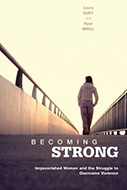Becoming Strong: Impoverished Women And The Struggle To Overcome Violence

Authors: Laura Huey and Ryan Broll
Publisher: Toronto: University of Toronto Press, 2018.
Reviewer: Richard Tewksbury | March 2019
Women who are homeless, victims of multiple forms of violence, often addicted or mentally ill and lacking significant social, financial, psychological, emotional and daily life supports are the focus of Huey and Broll’s engaging book Becoming Strong. As the book title suggests, the message of the book is that marginalized and victimized women can become strong, often already are (but not realized to be) strong, and there are ways that society and other individuals can assist women on the journal to becoming strong.
The book is based on three separate but intertwined interview-based studies with 187 homeless women in Chicago, Detroit and Los Angeles. There are no/few statistics in the book, but rather an abundance of compelling evidence — in the actual words of the women — to make a solid and convincing argument about the lives and personal qualities of these women. Becoming Strong is an easy to read book. It is not especially long (116 pages of text), but it is literally packed with the voices of these women explaining their own situations and their views on survival, growth and the future. The women come alive here, they are ever present and their words both clarify and expand on the conceptual text offered by the authors. One of the true strengths of this book is the abundance of quotes provided throughout the book. Essentially every single paragraph has multiple women’s voices expressing their experience of a concept or process. Reading this book feels like sitting in a group therapy session and listening to the women as they talk over one another and build on each other’s views and experiences. The integration of multiple short quotes to the presentation of each and every concept truly works to clearly illustrate the theoretical concepts, processes and forms of experience that are presented.
Huey and Broll state at the outset that “the central goal of this book (is) to pair women’s stories with what is known about trauma and resilience to help us better identify women’s strengths and build upon them in order to ease their transition into recovery” (p.4). This goal is not only achieved, it is achieved with a grace and finesse that is rare in scholarly works. Through the constant weaving of stories, short quotes and conceptual presentations the reader is taken by the hand and gently walked through what many might consider a maze of initially contradictory, unpopular and confusing processes. The book is laid out in seven fairly short, well organized, clearly structured chapters that lead the reader through the development of resilience and show the positive and negative consequences of various coping mechanisms and world views. The book leads the reader to three ideas proposed for human services to use to further the development of strength and resilience among these women. The ideas of recognizing resilience as a process, developing and using strengths-based approaches to therapeutic activities (especially a trauma informed care approach), and simply designing and making accessible social support services specifically for homeless and traumatized women are proposed as a next step in the process of addressing the needs of women.
The stories are often sad, anger-inducing and frustrating, yet also inspiring. The women of Becoming Strong are alive and generally very likable characters. These are not women of woe and loss who are to be pitied. These are women who are to be respected, admired and yes, also helped. Despite their marginalized and often ignored social status, Huey and Broll show us that these women are real people, and they have strengths, skills and value to add to the world. They may be in tough situations, but they (generally) have not given in to the pressures of their social world. Rather, they continue, and they show all of us that bad situations can be overcome. The key? This is the real conclusion of Huey and Broll; they key to going on, making progress in improving one’s station in life and pursuing a safe and content life is hope. As the book concludes: “Hope is not only essential to trauma recovery, but is fundamental to the ability of these women to succeed in building a better future” (p. 116).
Hope, resilience, perseverance and a belief that there is a reason to go on in life is what drives these women on a daily basis. These are the issues that are central to the abilities of not only homeless and traumatized women to become strong, but would seem to be a universal truth for us all.
Richard Tewksbury, Arizona State University


